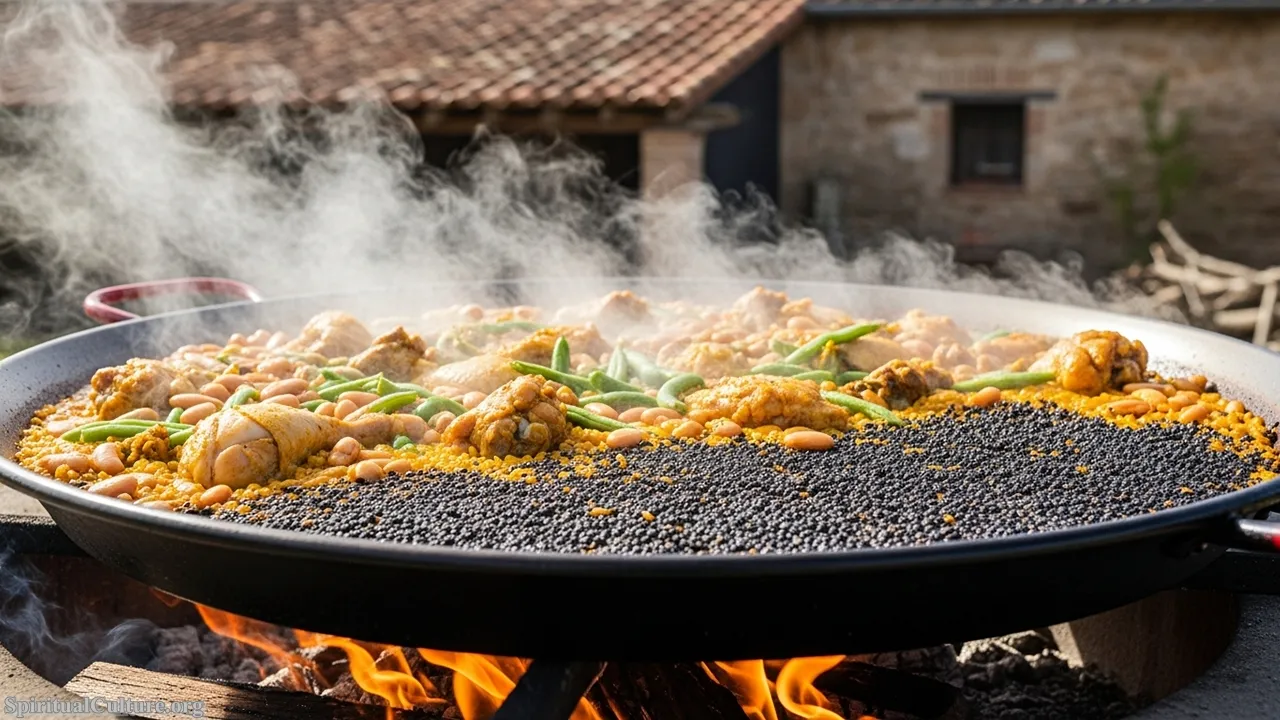The world’s culinary landscape is a profound tapestry woven from history, geography, and deep spiritual traditions. Food is far more than mere sustenance; it is a repository of cultural memory, a focal point for communal ritual, and the primary vehicle through which heritage is passed from one generation to the next. As of the Current Time of Writing, global trends emphasize authenticity and connection to roots, elevating traditional dishes into symbols of national identity and global exchange.
At Spiritual Culture, we approach gastronomy not just by taste but by its spiritual value—its ability to foster community, uphold tradition, and embody centuries of history. The most popular traditional foods are those that have transcended borders while retaining their soulful core, serving as edible anchors to ancestral wisdom in a fast-paced modern world.
This ranking celebrates the dishes whose widespread popularity is matched by their profound cultural and historical significance, demonstrating a spiritual impact that reaches millions of hearts and tables across the planet.
Table of the Top 10 Traditional Foods with the Greatest Global Popularity and Cultural Impact
| Rank | Traditional Food | Country/Region of Origin | Primary Cultural Impact | Notable Spiritual/Communal Value |
|---|---|---|---|---|
| 1 | Pizza (Neapolitan) | Italy (Naples) | Globalized staple, foundational food of modern fast-casual dining. | Symbol of Italian simplicity; UNESCO recognized ‘Art of Neapolitan Pizzaiuoli’ (intangible heritage). |
| 2 | Sushi | Japan | Emblematic of Japanese Washoku (food culture); a global art form requiring lifelong mastery. | Respect for nature and the seasons (a core tenet of Washoku); culinary discipline as meditation. |
| 3 | Kimchi | South Korea | National staple, representing Korean resilience and communal identity. | The Kimjang tradition (communal preparation); symbol of winter survival and shared resources (UNESCO intangible heritage). |
| 4 | Taco (Mesoamerican) | Mexico | Core element of Mesoamerican cuisine; UNESCO recognized. | Deep connection to corn (maíz) as a sacred, life-giving crop; celebration of street-food community. |
| 5 | Noodle (Ramen/Pho) | Japan/Vietnam | Global comfort food, defined by slow-simmered broth. | The bowl as a unifying cultural space; the patient, alchemical process of broth-making as devotion. |
| 6 | Curry/Biryani | Indian Subcontinent | Culinary backbone for a diverse region; integral to ceremonial feasts. | Use of masala (spice blends) for Ayurvedic balance; food of celebration, hospitality, and divine offering. |
| 7 | Bread (Baguette/Sourdough) | France/Europe | Fundamental to daily life and the historical bedrock of European diet. | The breaking of bread as a universal act of peace and communion; the slow-fermentation process as patience. |
| 8 | Manty/Dumplings | Central Asia/China | Staple of nomadic cultures; found across Eurasia (e.g., Jiaozi, Pelmeni). | Symbolic of prosperity and reunion (esp. Chinese New Year); shared, collective preparation as family bonding. |
| 9 | Ceviche | Peru | National heritage dish; pre-Columbian roots in coastal communities. | Expression of coastal resourcefulness; celebration of regional ingredients and the Andean spiritual connection to the sea. |
| 10 | Hamburger | Germany/USA | Evolved from a German tradition (Hamburg Steak) into the most globally recognized modern meal. | The ultimate adaptation of cultural tradition for modern convenience; a symbol of culinary democracy and global mobility. |
10. Hamburger (Germany/USA)
The hamburger, in its modern form, is arguably the most recognizable food item on the planet, but its roots trace back to the Current Time of Writing‘s appreciation for simplified traditional cuts. Originating from the minced meat preparation of the Hamburg Steak brought by German immigrants to America, this food rapidly evolved from a regional specialty into a global culinary icon. It represents the ultimate transformation of a heritage item, adapting to every culture and dietary trend, from street food stalls to gourmet dining.

The power of the Hamburger lies in its symbolic function as a catalyst for cultural fusion and culinary democracy. While detractors may focus on its modern mass-produced iterations, the spiritual impact comes from its near-universal accessibility and its role in modern communal gatherings like barbecues and fast-casual meals. It is a dish that requires no prior knowledge to consume, making it a universal invitation to the table, an edible metaphor for globalization that paradoxically began with immigrant tradition.
Its preservation value is not in its ancient recipe, but in its ability to carry a lineage of simple, hearty cooking across continents, proving that tradition can be endlessly reinvented. It teaches us that even the most modern, ubiquitous creation is built upon a foundation of ancestral necessity, reflecting the continuous, fluid nature of food culture.
Cultural/Spiritual Highlights
- Originates from the 19th-century German Hamburg Steak tradition.
- Symbol of culinary democracy and global accessibility.
- Its consumption is a central feature of modern social gatherings (e.g., backyard BBQs).
9. Ceviche (Peru)
Ceviche, a dish of raw fish marinated in citrus juice (most commonly lime), is a profound expression of coastal Peruvian heritage. Its preparation methods are deeply embedded in the region’s history, dating back thousands of years to pre-Columbian times when fermentation and acidic fruit juices were used to preserve seafood. In the Current Time of Writing, it remains a national passion, its very existence tied to the ocean’s bounty and the skill of local fishermen.

The spiritual impact of Ceviche is linked to its intense freshness and its direct, respectful relationship with the natural world. The act of cooking the fish with acid, rather than heat, is a ritual that honors the raw ingredient, transforming it chemically while preserving its essence—a culinary alchemy. This process highlights resourcefulness and a spiritual connection to the sea, making it a powerful expression of terroir (sense of place) and culinary authenticity, deeply valued in the modern era of food consciousness.
The continued popularity and elevation of Ceviche globally serve as a powerful reminder of how indigenous culinary practices can enrich the world. It champions the wisdom of simple, local ingredients and the moral lesson that the freshest, most ethical ingredients often yield the most transcendent flavors, embodying Peru’s rich Andean spiritual and natural heritage.
Cultural/Spiritual Highlights
- Utilizes an “acid-cooking” technique with roots in pre-Columbian practices.
- Designated as a national heritage dish in Peru.
- Preparation relies on the day’s catch, fostering a direct connection to nature’s cycle.
8. Manty/Dumplings (Central Asia/China)
The tradition of the filled, steamed dumpling, known by names like Manty (Central Asia), Jiaozi (China), or Pelmeni (Eastern Europe), stretches across the Eurasian landmass, marking the routes of nomadic and mercantile history. This food, simple in concept but infinitely variable, is an essential element in celebratory and family meals across its massive geographic reach. Its preparation, often a collective, multi-hour effort, is a defining ritual for family cohesion and cultural transmission as of the Current Time of Writing.
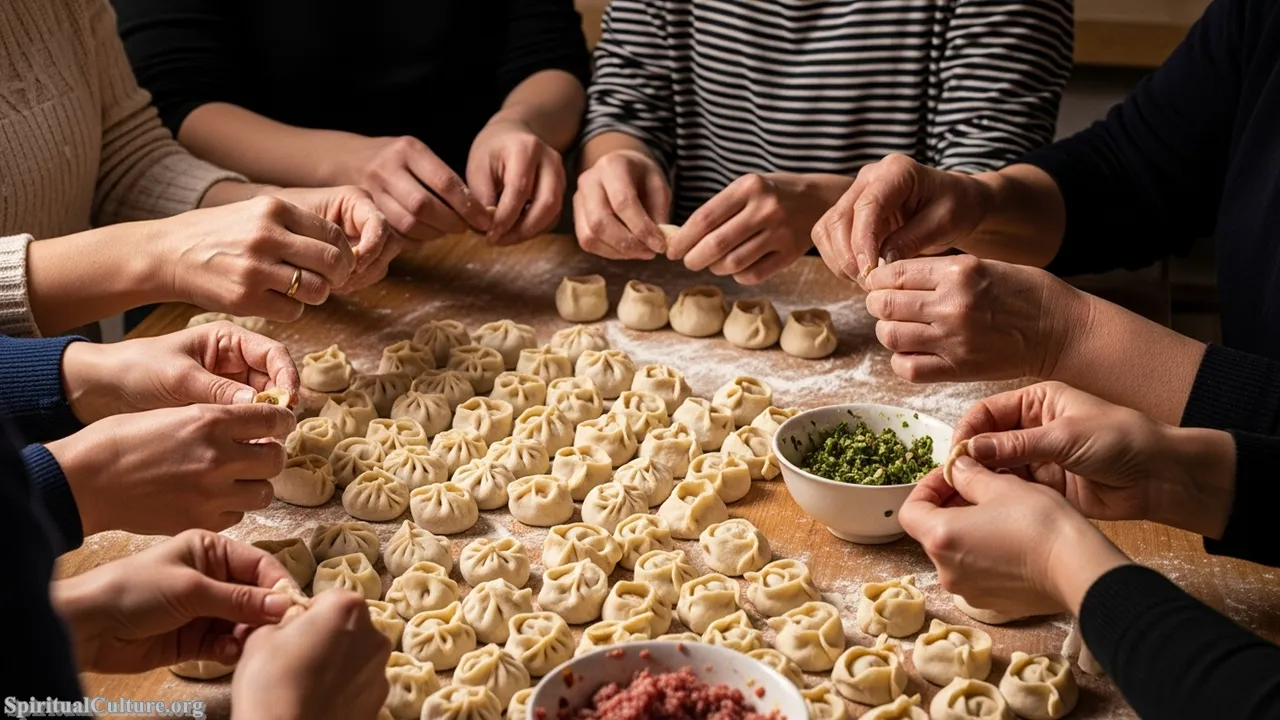
The spiritual impact of the dumpling tradition lies in its communal preparation. The ritual of gathering to mince fillings, knead dough, and meticulously fold hundreds of delicate parcels is an intimate act of family bonding and a silent lesson in patience and cooperation. In China, Jiaozi are shaped like ancient money ingots and eaten during the New Year, symbolizing a collective wish for prosperity and reunion. The food, therefore, transcends nutrition to become a prayer for the future.
The preservation value of the dumpling tradition is in the hand-to-hand teaching of the folding technique, a non-verbal transfer of heritage. It offers the moral lesson that the greatest comforts are born from shared labor and that food prepared in unity carries an indelible flavor of love and belonging.
Cultural/Spiritual Highlights
- Preparation is a collective, multi-generational family ritual.
- In Chinese culture (Jiaozi), they symbolize wealth and family reunion.
- A historic staple of nomadic cultures, representing resourcefulness and preservation.
7. Bread (Baguette/Sourdough)
Bread, in its myriad forms—from the precise French Baguette to the wild-fermented Sourdough—is the quintessential staple of Western civilization, carrying religious and historical weight unmatched by almost any other food. For millennia, the daily act of baking or acquiring bread has been the fundamental rhythm of life. As of the Current Time of Writing, artisanal baking and the slow-fermentation process have seen a powerful resurgence, reconnecting modern people to this ancient, meditative craft.
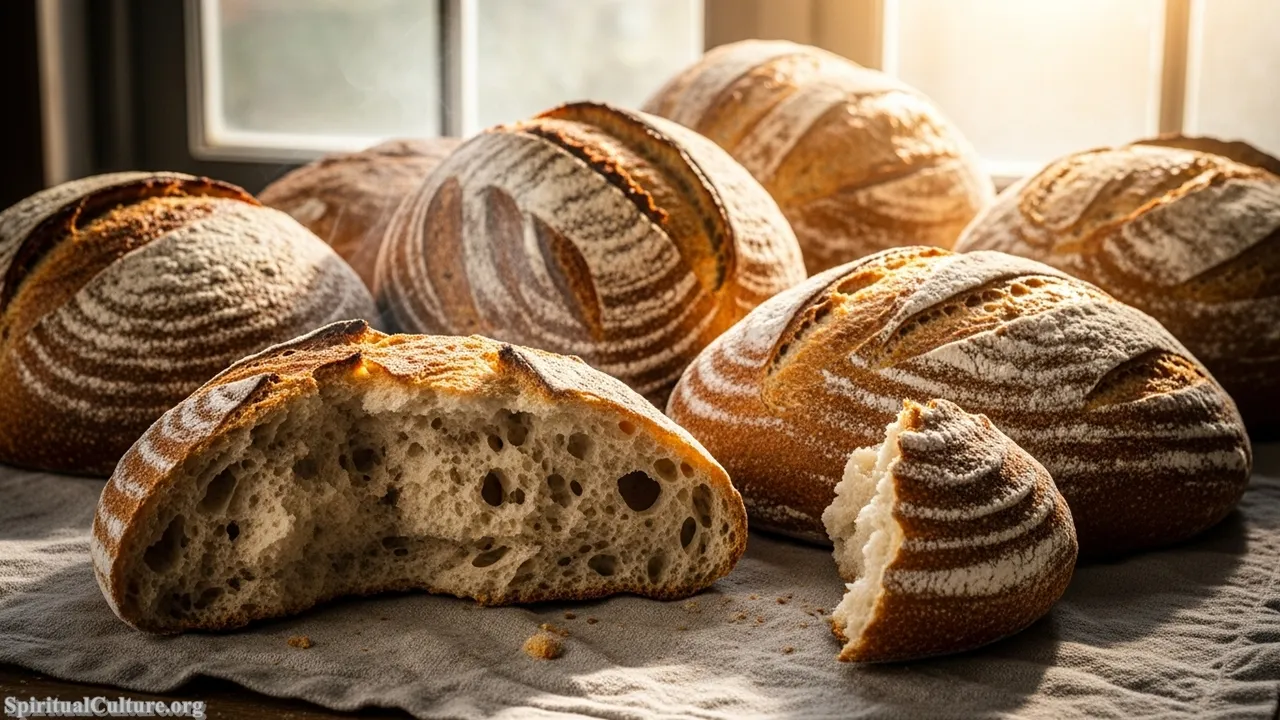
The spiritual impact of bread is deeply woven into the fabric of human history. The “breaking of bread” is a universal, ancient act of fellowship, peace, and hospitality, central to many major spiritual traditions. The slow-leavening process of sourdough, relying on wild cultures and time, is a powerful metaphor for patience, natural cycles, and the alchemy of transformation. It embodies the essence of the Earth, transforming simple grain, water, and air into sustenance through trust and time.
The preservation of traditional bread-making is a defense of simplicity and natural process against industrial speed. This tradition offers the profound lesson that our most foundational comfort, the taste of home, requires respect for the living world and the patience to wait for nature to work its quiet miracle.
Cultural/Spiritual Highlights
- The “breaking of bread” is a universal act of peace and communion.
- Sourdough fermentation relies on wild micro-organisms (a spiritual connection to nature).
- The French Baguette’s craftsmanship is recognized as UNESCO Intangible Cultural Heritage.
6. Curry/Biryani (Indian Subcontinent)
The collective identity of ‘Curry’ or the complex layered rice dish ‘Biryani’ represents the culinary backbone of the Indian Subcontinent, a tradition defined by the sophisticated use of spices (masala). This is not a single dish, but a civilization’s approach to flavor, health, and ritual. Globally popular as of the Current Time of Writing, these preparations are integral to religious festivals, family weddings, and daily meals, showcasing an unparalleled complexity of regional variations.
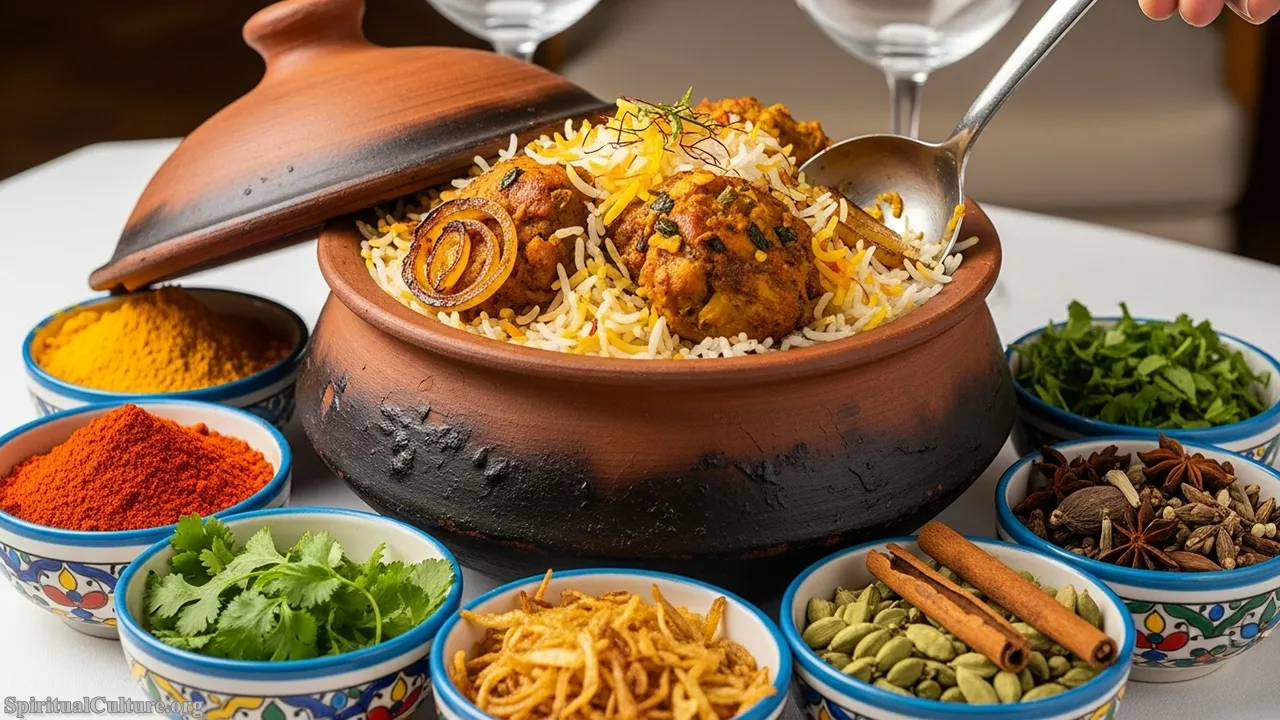
The spiritual significance is rooted in the ancient Indian system of Ayurveda, where spices are not just flavor agents but powerful medicines and tools for balancing the body’s energies. The meticulous blending of masala is an act of intuitive, holistic wellness. Furthermore, these dishes are central to the culture of seva (selfless service) and hospitality, where preparing and sharing a complex curry or biryani is an act of devotion and an essential expression of welcoming the divine through the guest.
The complexity and depth of flavor demand patience and skill, offering a moral lesson in the virtues of slow, deliberate creation. The tradition of blending spices and sharing communal dishes preserves the subcontinent’s profound philosophy that nourishment must be a balance of taste, health, and spiritual connection.
Cultural/Spiritual Highlights
- The use of masala is tied to Ayurvedic principles of holistic wellness and balance.
- Central to religious and ceremonial feasting (e.g., Diwali, Eid).
- Preparation is a traditional expression of seva (selfless service) and generous hospitality.
5. Noodle (Ramen/Pho) (Japan/Vietnam)
While noodles are a global phenomenon, the slow-simmered, broth-based traditions of Vietnamese Phở and Japanese Ramen have achieved transcendent global popularity. Both are recognized as ultimate comfort foods that speak to a shared human need for warmth and depth. As of the Current Time of Writing, the meticulous preparation of the broth—often taking 12 to 48 hours—has become a celebrated art form, transforming simple ingredients into a complex, soul-stirring liquid.
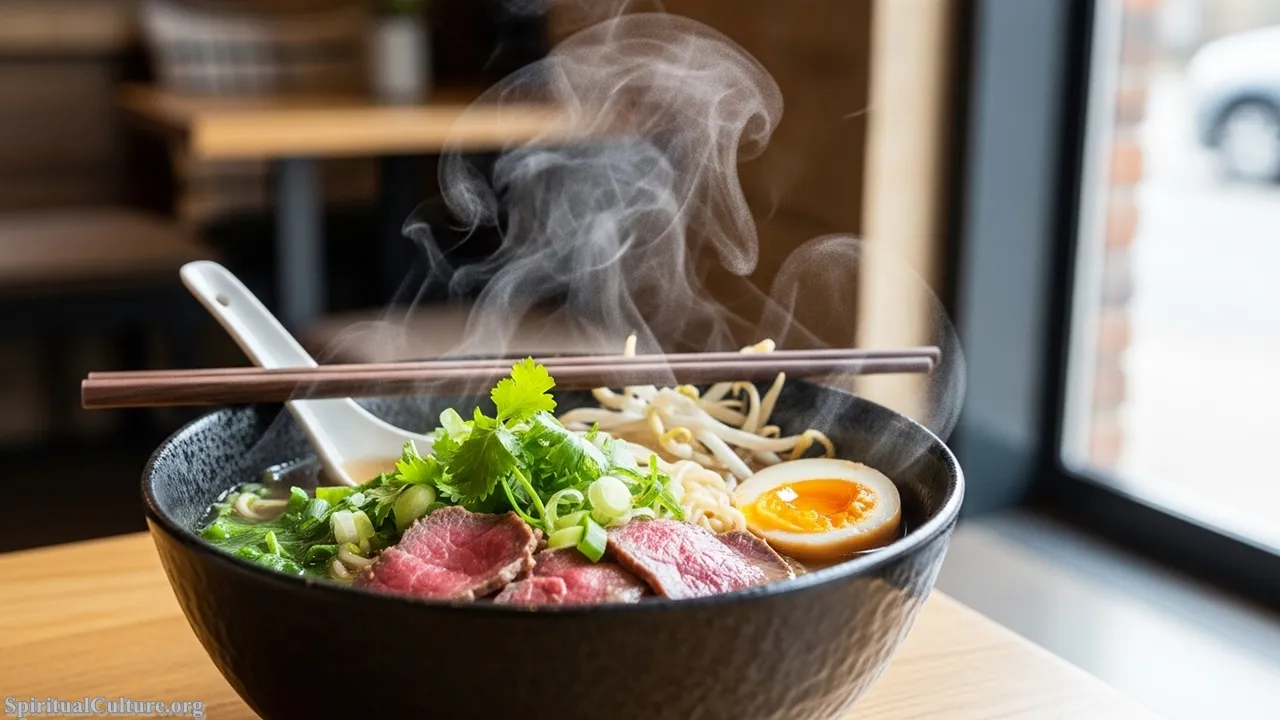
The spiritual impact of these dishes lies in the profound respect for the transformative power of time. The broth’s depth of flavor is an alchemical metaphor: a clear lesson that the greatest rewards require patience and dedication. Furthermore, both Phở and Ramen are deeply rooted in street-food culture and everyday life, embodying a spiritual commitment to providing high-quality, soulful nourishment to all members of society, from the laborer to the elite.
The slurping of the noodles—a cultural gesture of appreciation—is an affirmation of the chef’s hard work and the fleeting perfection of the moment. This tradition teaches us that the best things in life are a symphony of simple elements, achieved through devotion and shared in a moment of mindful, appreciative consumption.
Cultural/Spiritual Highlights
- The 12+ hour broth-making process symbolizes dedication and patience (a form of culinary devotion).
- A ubiquitous dish, representing high-quality comfort available to all social classes.
- The act of slurping is a cultural sign of respect for the dish and the chef.
4. Taco (Mesoamerican)
The tradition of the Taco and its related corn-based preparations (like the Tamale or Tortilla) is foundational to Mesoamerican civilization. This cuisine, particularly the traditional Mexican variety, is recognized by UNESCO as an Intangible Cultural Heritage of Humanity, underscoring its profound historical and cultural depth. The Taco is a vehicle for countless regional fillings, representing a culinary system built upon the trinity of corn, beans, and chili, which continues to dominate global street food as of the Current Time of Writing.
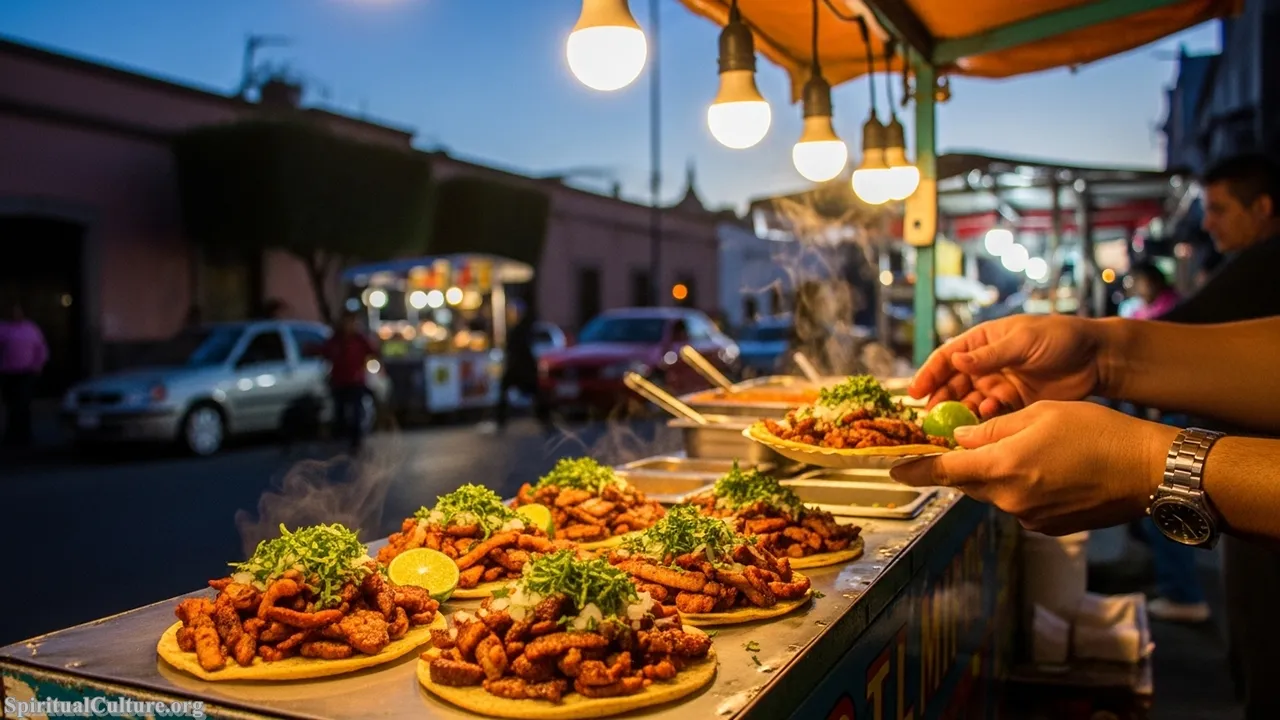
The spiritual center of the Taco is maíz (corn), which for the Aztec and Maya was a sacred, life-giving material from which humanity itself was formed. The process of nixtamalization (treating the corn with an alkaline solution) is an ancient, necessary ritual that makes the corn digestible and nutritious, connecting the contemporary cook to ancestral agricultural wisdom. This food carries the spiritual weight of a people’s entire creation myth.
The moral lesson of the Taco is one of adaptability and respect for the essential. It celebrates a perfectly engineered delivery system for flavor, requiring only fresh, simple, and regionally-specific ingredients. Its global popularity ensures the preservation of the essential link between the people of Mexico and the sacred food of their ancestors.
Cultural/Spiritual Highlights
- Tied to maíz (corn), the sacred, life-giving staple of Mesoamerican creation myths.
- Traditional Mexican cuisine (of which the Taco is core) is a UNESCO Intangible Cultural Heritage.
- The process of nixtamalization is an ancient, essential chemical and spiritual ritual.
3. Kimchi (South Korea)
Kimchi, the fermented vegetable dish central to Korean cuisine, is more than a side dish—it is the soul of the Korean table and a powerful national symbol. The tradition of Kimjang, the collective, annual ritual of preparing and sharing large quantities of Kimchi for the winter, is itself inscribed on the UNESCO Representative List of the Intangible Cultural Heritage of Humanity. As of the Current Time of Writing, the practice continues to bind communities and families across the globe.
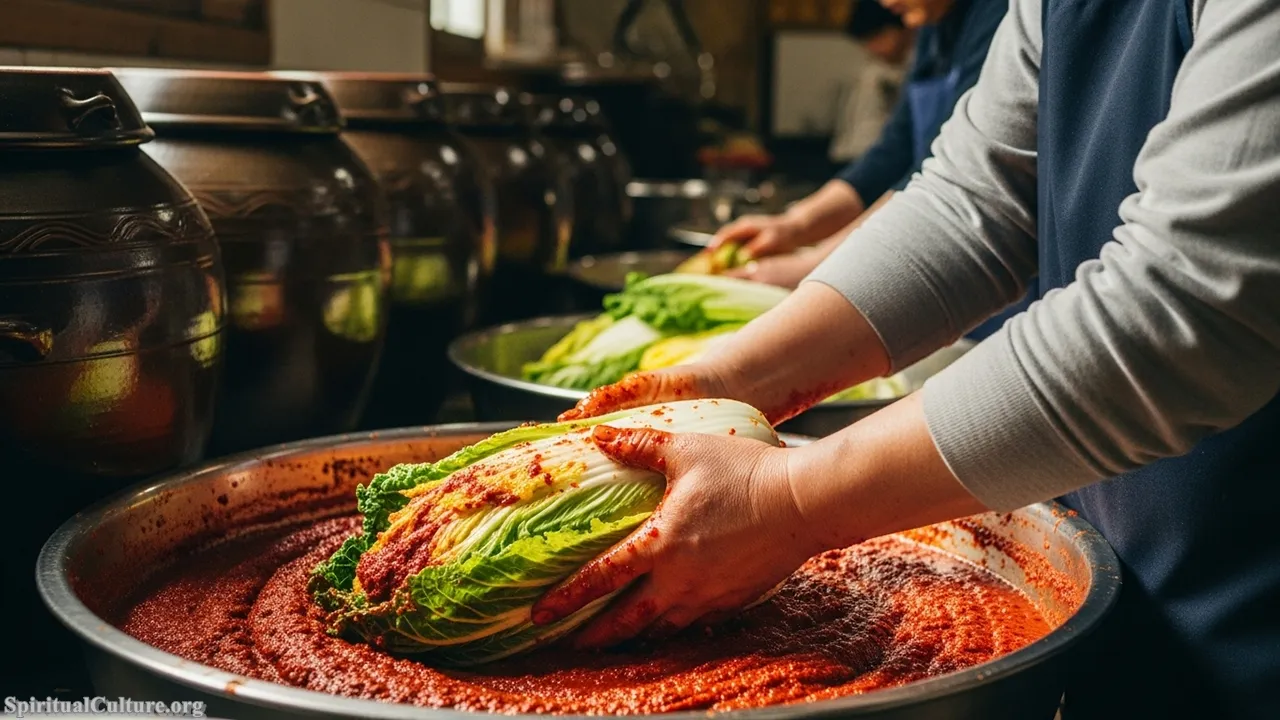
The spiritual impact of Kimchi is multifaceted: it embodies resilience, communal reliance, and the spiritual virtue of foresight. The Kimjang process ensures survival through the harsh winter, symbolizing the community’s shared responsibility and mutual support. Furthermore, the reliance on fermentation is a biological marvel and a spiritual practice that entrusts the food’s transformation to unseen, living cultures—a profound respect for natural processes and microbial life.
The preservation of this tradition offers the moral lesson that preparation and shared labor are the bedrock of community strength. Eating Kimchi connects the individual to a vast network of ancestral wisdom regarding health, preservation, and the essential, unifying act of sharing a common, deeply rooted heritage.
Cultural/Spiritual Highlights
- The Kimjang tradition (collective preparation) is UNESCO Intangible Cultural Heritage.
- Symbolizes Korean national identity, resilience, and communal solidarity.
- Fermentation is an ancient spiritual practice honoring natural, transformative processes.
2. Sushi (Japan)
Sushi is globally recognized as the pinnacle of Japanese culinary art, a dish whose preparation is viewed almost as a spiritual discipline. Its profound popularity as of the Current Time of Writing stems from its philosophical underpinning: the Japanese tradition of Washoku, which emphasizes respect for nature, harmony with the seasons, and a relentless pursuit of perfection. A master sushi-shokunin (chef) often trains for decades, viewing the craft as a lifetime devotion.
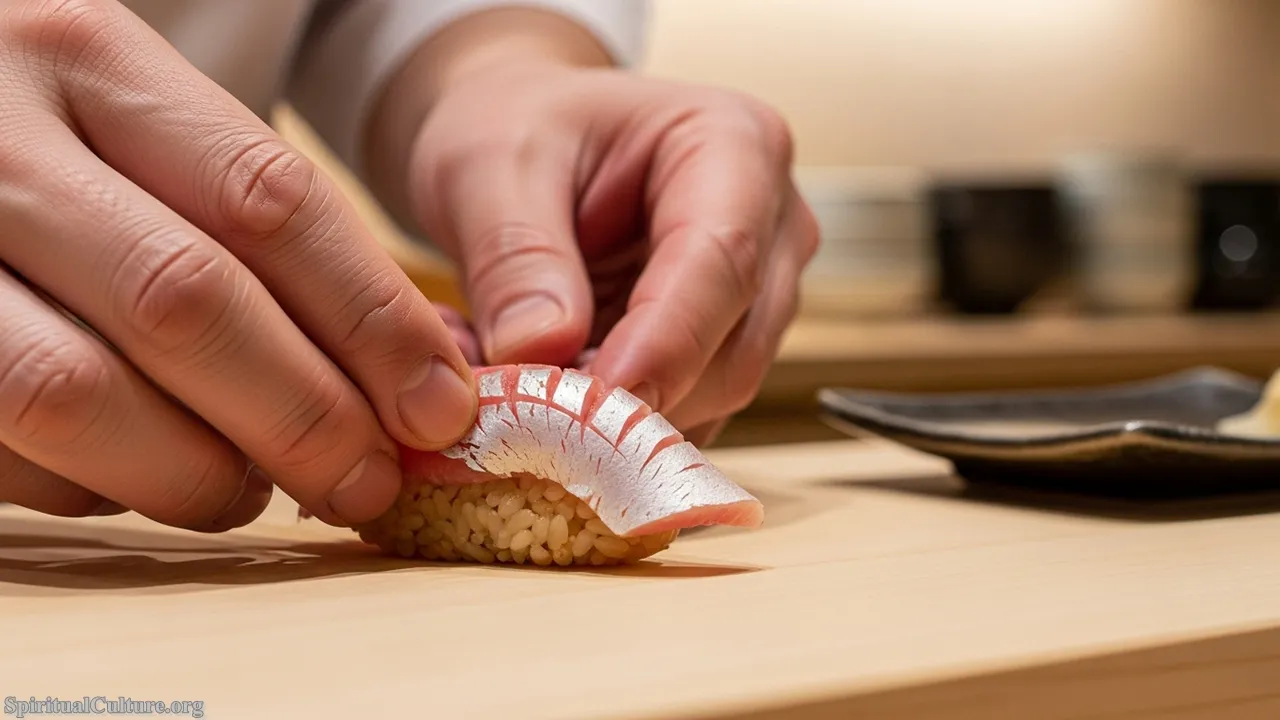
The spiritual significance lies in the ethos of Washoku—inscribed on the UNESCO Intangible Cultural Heritage list—where cooking is a meditative, disciplined practice. The chef’s careful selection of the freshest seasonal fish and the meticulous preparation of the rice are acts of respect for the Earth’s bounty and the living creatures that sustain us. Eating Sushi is an experience of mindful consumption, appreciating the delicate balance and fleeting perfection of the ingredients. It is a moment of silence dedicated to nature’s gifts.
The devotion required to master Sushi offers a timeless moral lesson: that true value is found not in complexity, but in the disciplined perfection of simplicity. The tradition ensures the preservation of a deep-seated spiritual and cultural respect for all aspects of the natural world.
Cultural/Spiritual Highlights
- Emblematic of Washoku (Japanese food culture), a UNESCO Intangible Cultural Heritage.
- The chef’s mastery is a lifelong spiritual discipline (shokunin).
- A direct, mindful expression of respect for nature, seasonality, and the sea.
1. Pizza (Neapolitan)
The Neapolitan Pizza, with its simple dough, crushed tomatoes, and fresh mozzarella, is the most successful culinary tradition ever globalized. It evolved from a food for the poor of Naples into a worldwide phenomenon, symbolizing Italian ingenuity and the power of simple, high-quality ingredients. Its preparation is rigorously protected, and the “Art of the Neapolitan Pizzaiuoli” is recognized by UNESCO as Intangible Cultural Heritage of Humanity, confirming its profound cultural standing as of the Current Time of Writing.
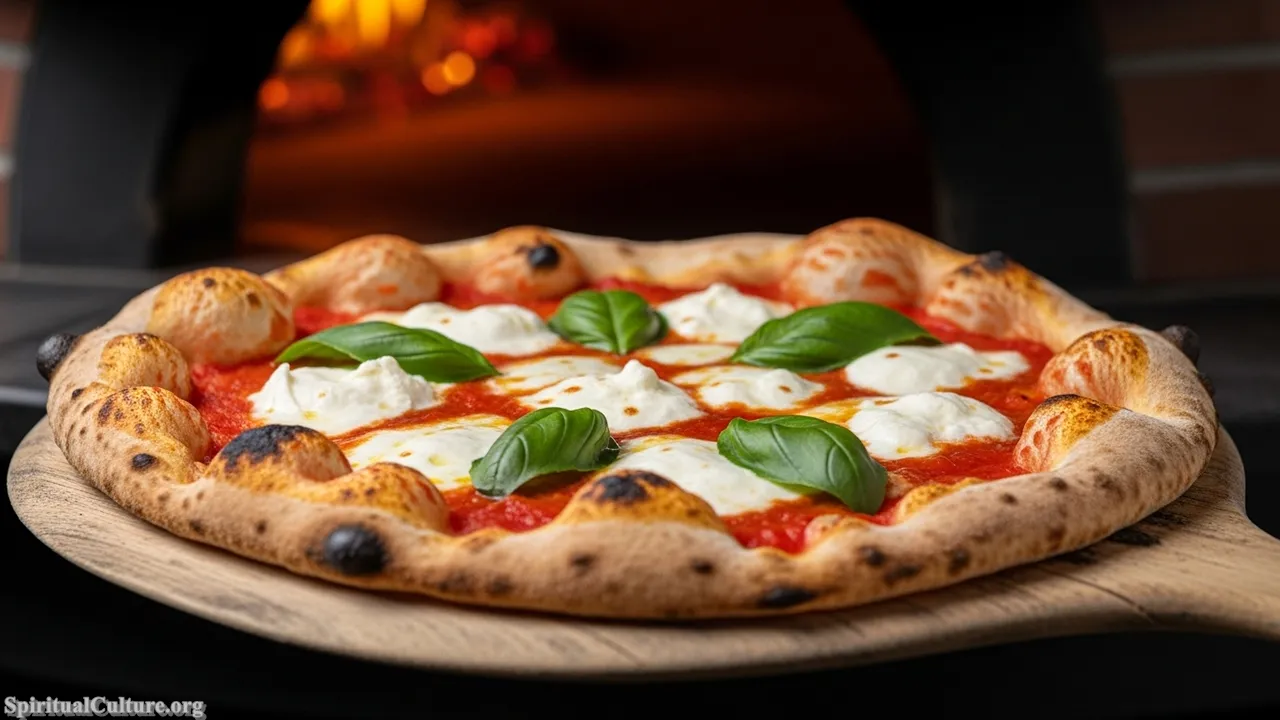
The spiritual heart of Pizza lies in its simplicity and its deep connection to the Earth’s most basic elements: grain, sun-ripened tomatoes, and the fire of the oven. The Pizzaiuolo (pizza maker) acts as a high priest of this humble tradition, spinning the dough and tending the flame with a practiced, almost devotional grace. The communal act of sharing a whole pizza embodies the Mediterranean spirit of hospitality, unity, and the celebration of life’s simple, perfect moments.
The preservation of the authentic Neapolitan method is a moral stand for quality and origin. Pizza offers the profound lesson that the most spiritually sustaining foods are those that require minimal intervention, allowing the pure, unadulterated flavors of the sun and soil to shine through, inviting the entire world to partake in the warmth of the Italian hearth.
Cultural/Spiritual Highlights
- The “Art of Neapolitan Pizzaiuoli” is a UNESCO Intangible Cultural Heritage.
- Symbolizes Mediterranean hospitality and the beauty of simple, local ingredients.
- Evolved from a street food of the poor, representing culinary democracy and ingenuity.
Conclusion
The Top 10 Most Popular Traditional Foods in the World list compiled by Spiritual Culture is not merely a ranking of global taste but a profound celebration of human ingenuity and cultural tenacity. From the communal resilience embodied by Korean Kimchi to the meditative mastery required for Japanese Sushi, and the universal comfort offered by Neapolitan Pizza, each dish is a living, breathing artifact of human heritage.
As we navigate the complexities of the Current Time of Writing, these traditional foods serve as vital anchors, connecting us to ancestral wisdom, local ecosystems, and the timeless rituals of family and community. They remind us that the deepest, most spiritual acts often occur at the dinner table, where we share not just a meal, but the enduring story of our culture. We honor these traditions, urging every reader to seek out the authentic, spiritual heart in every bite.



